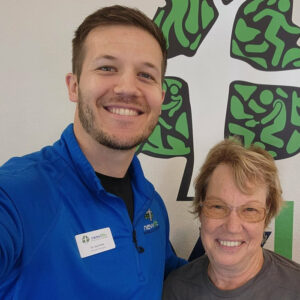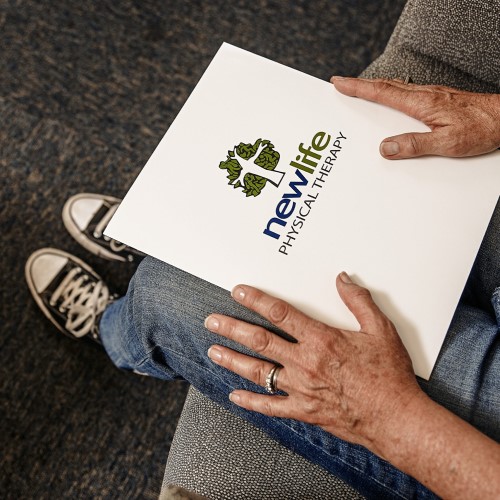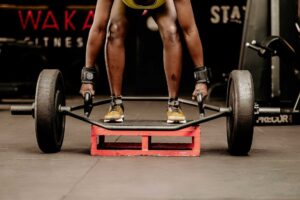On Wednesday, May 15, 2024 from 5:30pm - 6:30pm, we are hosting a FREE Foot Pain Workshop [ Online
] - Click here for more info
Loretta’s Story

Joe Shultz helped me to heal my injured right shoulder. He kept things simple and easy to follow as he diagnosed my limited movement and pain issues. I now have returned strength without pain and can go about my life as prior to my injury. Thanks so much New Life. And my new friend Joe.
-Loretta S
Jefferson Deadlift

Next up in this series of “pick stuff off the floor” movements is a “historic” lift: the Jefferson Deadlift. This lift was used in the past by strongmen as a variation on the deadlift motion, often to pick up something awkward such as heavy stones. It has regained favor in the lifting community recently due to its ability to target muscles missed with other techniques.
Once again, the deadlift has caught on so much in the rehab world due to its utility. It is hard to beat the function of picking something up…we all need to at some point or another. Plus, if you can pick yourself PLUS a weight then getting yourself alone up should be easier. With the Jefferson deadlift, we bring in the concept of asymmetry – intentionally creating some overload on one side and then the other. Very rarely can we pick a real-world object up with 100% optimal positioning. Hard to get more functional than that. So, let’s get to it.
The Jefferson deadlift starts out differently right from the foundation. Instead of standing with the bar in front of you, you will straddle the bar with one foot. This allows you to crouch more than hinge, thus involving the quadriceps on the front of your thighs, as well as avoids potentially aggravating flexion if your lower back is currently sore. The foot that is behind the bar has the toe turned out while the foot that is over the bar is straight ahead. The hands will match this: “behind hand” is turned thumb out while the “forward hand” is over the top of the bar.
Same as on the conventional deadlift, one quick aside is that if you are lifting with a barbell, the standard diameter 45 pound plate is considered the normal height for the rack pull. If you are unable to lift 135 pounds (a pair of 45 pound plates on a 45 pound bar) then you’ll either need to try using “bumper plates” or find some way to build the bar up to about 8 inches from the floor. Bumper plates are rubber plates that are the same diameter as the standard 45 pound plate, no matter the weight.
Once you have the bar set up it is go time. You will crouch down to grasp the bar with your hands, remembering to turn out the back hand to match that foot. Bring your chest up and tighten the elbows up. Take your deep breath, push off, and then blow the air out once the bar crosses your knee line. Now, the bar will get a little “friendly” with you since you are standing right over it. Try to still stand up as tall as possible. Do not let the bar twist and try to keep your chest tall and pointing the same direction that it started in. You did it!
From there, the lowering is just reversing the motion. Keep your upper body tight while you crouch your legs to lower it back to the ground. Stay in control.
To summarize and give a check list: straddle the bar with the front foot forward and the back foot turned out. Crouch to grasp the bar, with hands matching the feet. Build your upper back tension. Breath in. Push yourself up and let the air come out until you stand tall. Do not let it twist you.
Training a Jefferson deadlift can address some left versus right differences that might get missed with conventional lifting. It is a great tool to work on addressing imbalances. It involves more muscles and can be used with lower back soreness to avoid potentially uncomfortable flexion. Get out there and give it a try, but please talk to your New Life Physical Therapy provider if you have any questions about lifting or need guidance.
The Jefferson Deadlift

Next up in this series of “pick stuff off the floor” movements is a “historic” lift: the Jefferson Deadlift. This lift was used in the past by strongmen as a variation on the deadlift motion, often to pick up something awkward such as heavy stones. It has regained favor in the lifting community recently due to its ability to target muscles missed with other techniques.
Once again, the deadlift has caught on so much in the rehab world due to its utility. It is hard to beat the function of picking something up…we all need to at some point or another. Plus, if you can pick yourself PLUS a weight then getting yourself alone up should be easier. With the Jefferson deadlift, we bring in the concept of asymmetry – intentionally creating some overload on one side and then the other. Very rarely can we pick a real-world object up with 100% optimal positioning. Hard to get more functional than that. So, let’s get to it.
The Jefferson deadlift starts out differently right from the foundation. Instead of standing with the bar in front of you, you will straddle the bar with one foot. This allows you to crouch more than hinge, thus involving the quadriceps on the front of your thighs, as well as avoids potentially aggravating flexion if your lower back is currently sore. The foot that is behind the bar has the toe turned out while the foot that is over the bar is straight ahead. The hands will match this: “behind hand” is turned thumb out while the “forward hand” is over the top of the bar.
Same as on the conventional deadlift, one quick aside is that if you are lifting with a barbell, the standard diameter 45 pound plate is considered the normal height for the rack pull. If you are unable to lift 135 pounds (a pair of 45 pound plates on a 45 pound bar) then you’ll either need to try using “bumper plates” or find some way to build the bar up to about 8 inches from the floor. Bumper plates are rubber plates that are the same diameter as the standard 45 pound plate, no matter the weight.
Once you have the bar set up it is go time. You will crouch down to grasp the bar with your hands, remembering to turn out the back hand to match that foot. Bring your chest up and tighten the elbows up. Take your deep breath, push off, and then blow the air out once the bar crosses your knee line. Now, the bar will get a little “friendly” with you since you are standing right over it. Try to still stand up as tall as possible. Do not let the bar twist and try to keep your chest tall and pointing the same direction that it started in. You did it!
From there, the lowering is just reversing the motion. Keep your upper body tight while you crouch your legs to lower it back to the ground. Stay in control.
To summarize and give a check list: straddle the bar with the front foot forward and the back foot turned out. Crouch to grasp the bar, with hands matching the feet. Build your upper back tension. Breath in. Push yourself up and let the air come out until you stand tall. Do not let it twist you.
Training a Jefferson deadlift can address some left versus right differences that might get missed with conventional lifting. It is a great tool to work on addressing imbalances. It involves more muscles and can be used with lower back soreness to avoid potentially uncomfortable flexion. Get out there and give it a try, but please talk to your New Life Physical Therapy provider if you have any questions about lifting or need guidance.
Diaphragmatic Breathing – Part II

Diastasis Rectus Abdominis (DRA)

Diastasis Recti is a common impairment of the abdominal wall where the abdominal muscles separate along the midline of the abdomen at the linea alba. The rectus abdominis muscle runs vertically along the front of your stomach. It is divided into left and right sides by a band of connective tissue called the linea alba that runs down the middle. Often during pregnancy, especially during the third trimester, the muscles expand and stretch with the quickly growing uterus and baby. Once you deliver your baby, the linea alba can heal and come back together because it is highly elastic. But if that tissue is overstretched and loses the elasticity, the gap might not fully close, resulting in a DRA.
Here are some symptoms that could be an indication.
While lying on your back with knees bent up, lift your head off the floor. Place your fingers in the gap or separation. A separation of 2 finger widths or less is considered normal, anything greater is considered having a DRA.
Risk factors for developing more significant DRAs could include multiple pregnancies and pregnancies close together where you might not have fully recovered, being over 35 years of age when pregnant, have multiples (twins, triplets, etc.), having a big baby, being petite, and having a vaginal delivery with pushing which increases abdominal pressure.
If you suspect you have a DRA, do not worry. Almost 60% of women experience this after pregnancy. You will want to have it assessed at your next doctors visit or come see a pelvic health physical therapist who can assess and get you started on the best movements and core
strengthening exercises based on the level of your separation and your overall condition. The focus is strengthening your inner core muscles without increasing intra-abdominal pressure. You want to avoid movements and exercises that cause that “pooching” to occur. Starting with the basics of diaphragmatic breathing, transverse abdominus setting, pelvic floor muscle activation, and postural awareness is key. Initially, traditional core exercises might be too advanced, but as you get stronger in your inner core, then you can progress with more arm/leg movements and multi directional work.
Initially, if DRA is significant, binders can be helpful for postural support and approximating the rectus borders, however, avoid dependency on these. Transitioning to active core strengthening early on is the ideal.
Due to hormonal changes in our body and the rapidly growing baby during pregnancy, some separation is normal and expected. Things to work on to minimize that overstretching during pregnancy are as follows…
If your DRA is severe and you continue to have symptoms despite building your core strength, or you have concerns about your appearance, surgery called abdominoplasty may be an option. This is only recommended when you decide you are done having children. It is often encouraged to work on your core strength for at least a year before you decide to have this done. Talk to your doctor about the pros and cons and what kind of recovery is involved.
Our pelvic health and core experts at New Life PT can guide you if you aren’t sure where to start. Give us a call 608.742.9356 or send us an email scheduling@newlifept.com to be scheduled for an initial evaluation and determine what options are available to you.
Our My Core Floor program has great workouts to improve core strength and DRA and also some good talks/guest speaker series to reference for DRA as well, so just another great resource to utilize.
Lifestyle Success in 2024

As we approach a new year, many will focus on improved health in 2024. While “lose weight” and “exercise” more are popular areas of focus, there are a variety of other opportunities to improve your health. Big changes all at once can set us up for failure. Try picking one or two larger items, or a few smaller items. After being successful in integrating it into your lifestyle, consider adding another. It can take a whopping 66 days of consistency to make something a habit. If you want long-term results, plan on slow and steady changes to implement throughout the year and beyond!
Set a specific goal, indicate why changing is important for you, and track the efforts you are making. Measure if you are making progress towards your goal. If you are, look at what efforts/behaviors were behind that. If you are not making progress towards your goal, identify areas of problem behavior or focus needed. Reach out to Dr. Mary Rose Strickland: DrMaryRose@newlifept.com with any individual or specific questions regarding how to meet your lifestyle goals this year!